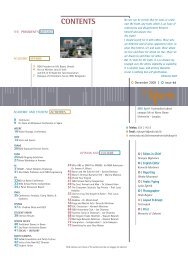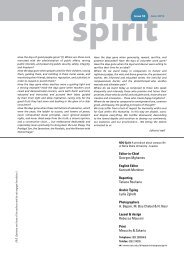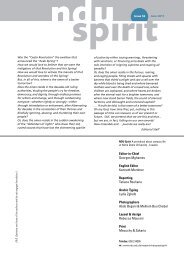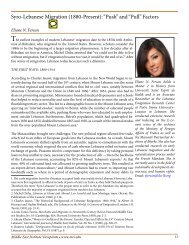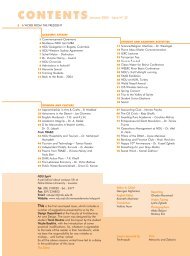OUTLINE - Notre Dame University
OUTLINE - Notre Dame University
OUTLINE - Notre Dame University
You also want an ePaper? Increase the reach of your titles
YUMPU automatically turns print PDFs into web optimized ePapers that Google loves.
According to Proshansky, Fabian,<br />
and Kaminof, the child psychologists,<br />
"Certain spaces and places,<br />
because they are ‘owned’, familiar,<br />
and useful and can be controlled,<br />
satisfy and maintain the integrity of<br />
the child’s sense of self, including<br />
the definition of that self."<br />
The control of space is concretized<br />
when the child perceives from the<br />
path neutral objects inside that he<br />
has no control over from the outside.<br />
The transparent container disappears<br />
(is no more perceived) as the<br />
child gets within the physical space.<br />
As he plays, wanders, and fantasizes<br />
within the mitochondrion, the<br />
objects contained are controlled by<br />
the child's actions and space indulgence<br />
and perception. The object<br />
contained becomes imprinted on the<br />
child as long as he plays within the<br />
space, sees the object moving, and<br />
creates a corner for his exhibition<br />
place and for his privacy.<br />
The path connects with two<br />
entrances for the project, which are<br />
provided to facilitate the process of<br />
sorting the children on their way to<br />
the inside, according to the criteria of<br />
number and character.<br />
The in-project entrance filters children<br />
according to age on the basis of<br />
Piaget's stages of child development:<br />
➠ Zone 1: age 0 to 3<br />
➠ Zone 2: age 3 to 7<br />
➠ Zone 3: age 7 to 12<br />
Zone 1, age 0 to 3: sensorial-motor<br />
stage of child development:<br />
Children at this early age are characterized<br />
by 1) inability to represent<br />
three-dimensional objects, 2)<br />
unawareness of object permanence,<br />
3) little motor competence, 4) awareness<br />
of images and faces, 5) no<br />
awareness of time and space and 6)<br />
no spatial coding.<br />
The zone is constituted of an ellipse<br />
elongated and without an edge, having<br />
the same touch along the peripheral<br />
envelope, uninterrupted space,<br />
a free plan with no separation, and<br />
orientation by the child himself by a<br />
landmark, "the Duffy".<br />
The Duffy is situated in front of the<br />
entrance. It is constituted of planes<br />
separated by an empty physical<br />
space. As the child enters and starts<br />
moving along the elliptical periphery,<br />
the Duffy starts to separate. The<br />
combination of Duffy 2-dimensional<br />
images forms the whole, and the<br />
combination of two consecutive 2-d<br />
images provide a useful space to<br />
play in. The assimilation between<br />
the two consecutive images and the<br />
useful space introduces the awareness<br />
of the three-dimensional object<br />
that has width, depth, and height.<br />
The concavity of the ellipse in the<br />
vertical and horizontal planes provides<br />
a physical obstacle between<br />
the adult supervisor and the child.<br />
The adult has to go down on his or<br />
her knees and lean down in order to<br />
invade the child's space.<br />
Zone 2, age 3 to 7: pre-operational<br />
stage of child development:<br />
Children at this age are characterized<br />
by 1) unawareness of the principal<br />
of conservation, 2) the use of<br />
symbols and make-believe, 3) egocentricity<br />
and little capacity for logical<br />
thought<br />
An ascending ramp is provided to<br />
enable the child between age 3 and<br />
age 12 to reach its physical setting.<br />
Moreover, the child has to pass over<br />
a bridge above zone 1 to arrive there.<br />
The bridging ramp that is recommended<br />
by child psychiatrists fosters<br />
the child’s sense of self. It develops<br />
the sense of challenge and<br />
strengthens self-esteem. It develops<br />
a sense of the force of gravity and<br />
improves balance.<br />
The development of logical thought<br />
is highly dependent on logico-mathematical<br />
classification, seriation and<br />
the concept of number.<br />
The physical setting is constituted of<br />
unit objects that are assimilated<br />
together in a geometrical manner.<br />
This assimilation is based upon the<br />
articulation of solid and void to form<br />
the object contained.<br />
Perceiving and manipulation of unit<br />
objects with other unit objects develops<br />
the concepts used in logical<br />
thought. Perceiving and experimenting<br />
depends on the manipulation<br />
and seriation of unit objects.<br />
This idea is based upon the theory of<br />
cognitive development elaborated<br />
by Piaget.<br />
Zone 3, age 7 to 12: concrete operational<br />
stage of child development:<br />
During this stage, children are characterized<br />
by 1) a more logical manner<br />
of thinking, 2) a start to overcom<br />
ing egocentricity, 3) learning the<br />
idea of reversibility, 4) conceptualizing<br />
in the mind without seeing the<br />
action, and 5) a better understanding<br />
of time and place, but 6) a continued<br />
limitation of powers of abstract<br />
thinking.<br />
The zone devoted to them establishes<br />
a relation between object and<br />
trace and discontinuity between<br />
objects. Objects (physical settings)<br />
are arranged along the vertical plan<br />
to constitute a grid in the vertical<br />
plan. Physical settings for encountering<br />
an activity tend to disappear<br />
and reappear in different horizontal<br />
plans of different levels. A stairway<br />
46 NNU SPIRIT




